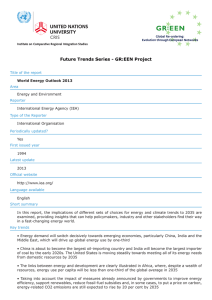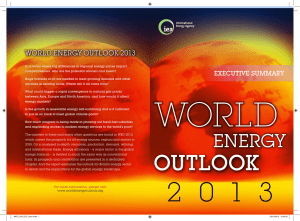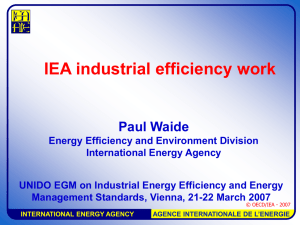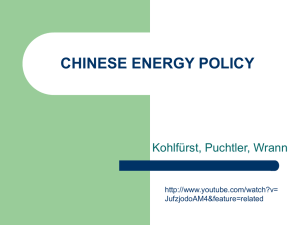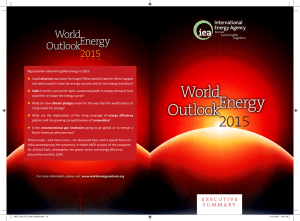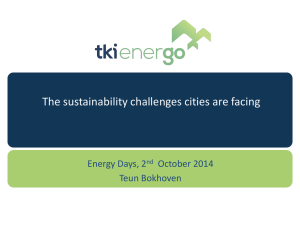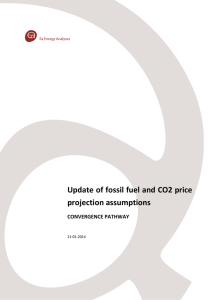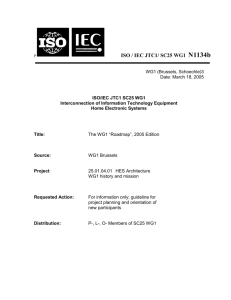Presentatie Lucia van Geuns
advertisement
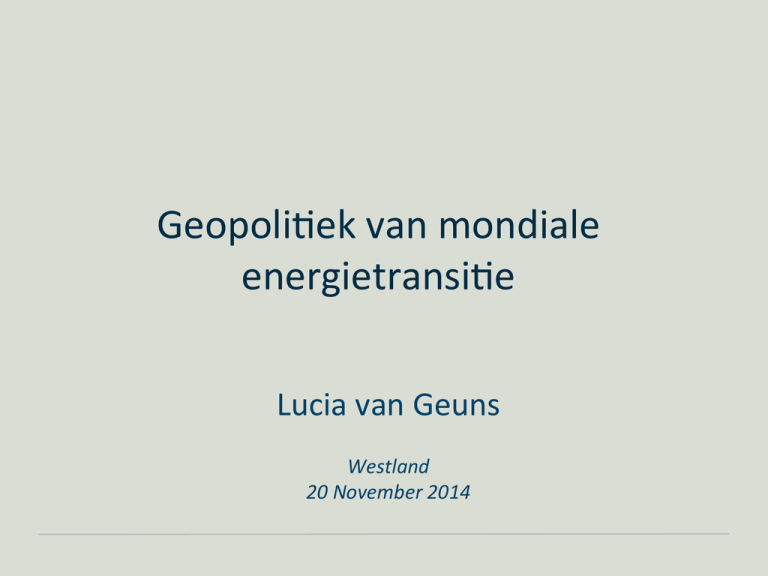
Geopoli'ek van mondiale energietransi'e Lucia van Geuns Westland 20 November 2014 Agenda • De interna'onale energie context • Drijvende krachten achter energiemarkten • Discussie Ontwikkeling van de energie vraag Source: Smil, Energy Transitions; ExxonMobil Global Percent Mix of Fuels Other Renewables 100 Nuclear Hydro 80 Gas 60 Oil 40 20 0 Coal Biomass 1800 1850 1900 1950 2000 The Tale of Two Worlds OECD Energy Demand Non OECD Energy Demand Quadrillion BTUs Quadrillion BTUs 500 500 400 400 Rest of Non OECD Russia/Caspian 300 Africa 300 Middle East Rest of OECD 200 Latin America 200 India Europe OECD 100 100 China North America 0 1990 2015 2040 0 1990 2015 2040 Source: Exxon, 2012 Niet-­‐OESO drijD de groeiende energievraag Source: BP energy Outlook 2030, 2012 Toenemende vraag naar energie Beinvloed door bevolkingsgroei en economische groei Billion 9 World Population 6 3 1800 0 1900 2000 Source: United Nations; ExxonMobil 2040 Het mondiale energiesysteem in beweging (EIA WEO 2014) S'lte voor de storm? -­‐ onrust in het MO: onzekere oliemarkten -­‐ oplaaiend debat gasveiligheid Europa KlimaaRop Parijs 2015: gemengde signalen -­‐ mondiale CO2 uitstoot sAjgt nog steeds -­‐ subsidies fossiele brandstof (550 MM$) 4x > duurzame energie -­‐ energie besparingsmaatregelen lijken succesvol Verandering in het modiale energie systeem: gedreven door beleid of gebeurtenissen? Energy: a global overview • Oil is 70% transporta'on fuel; remaining 30%: plas'cs, asphalt etc • Natural gas = heat & electricity • Coal, gas, hydro, nuclear and alterna'ves create electricity • Subs'tu'on op'ons are small Energie oplossingen Meer efficiency Technologie Minder CO2 uitstoot Meer aanbod source: Exxon Mobil 2008 The door to 2°C is closing, but will we be “locked-­‐in” ? Gt World energy-­‐related CO2 emissions in the Current Policies and 450 Scenarios and from locked-­‐in infrastructure in 2010 and with delay 50 45 40 35 30 25 20 15 10 5 0 2010 6°C trajectory 2°C trajectory Delay un)l 2017 Delay un)l 2015 Emissions from exis)ng infrastructure 2015 2020 2025 2030 2035 Without further acAon, by 2017 all CO2 emissions permiNed in the 450 Scenario will be “locked-­‐in” by exisAng power plants, factories, buildings, etc. Source: IEA WEO 2011 Coal won the energy race in the first decade of the 21st century Mtoe Growth in global energy demand, 2000‑2010 1 600 1 400 Nuclear 1 200 Renewables 1 000 800 Oil 600 400 Natural gas 200 0 Total non-­‐coal Coal Coal accounted for nearly half of the increase in global energy use over the past decade, with the bulk of the growth coming from the power sector in emerging economies Source: IEA WEO 2011 The long wavelength transi'on to a low carbon economy • Today renewable sources* account for no more than 2% of global energy and this will rise to only about 6% by 2030 • Renewables remain dependent on policy support • Renewable energy will become very widely used in the future, but not in our life'mes • Reduce costs: increasing energy efficiency and switch from coal to gas in power genera'on * Excl. hydro BP Sta's'cal Review of World Energy 2013 A mix that is slow to change Growth in total primary energy demand 1987-­‐2011 Gas 2011-­‐2035 Coal Renewables Oil Nuclear 500 1 000 1 500 2 000 2 500 3 000 Mtoe Today's share of fossil fuels in the global mix, at 82%, is the same as it was 25 years ago; the strong rise of renewables only reduces this to around 75% in 2035 Source: IEA, WEO 2013 2010-­‐2014: Reminders of Security of Supply Vulnerability Oil and Gas Import Dependence In any scenario we need more gas from outside the EU… IEA, WEO, 2102 Net oil & gas import dependency in selected countries Japan Gas Imports 100% 2010 2035 80% European Union 60% 40% China 20% United States 0% Gas Exports 20% 20% 40% 60% India 80% 100% Oil imports While dependence on imported oil & gas rises in many countries, the United States swims against the Ade A power shiD to emerging economies Source: IEA WEO 2012 Change in power genera)on, 2010-­‐2035 Coal Gas Nuclear Renewables China India United States European Union Japan -­‐1 000 0 TWh 1 000 2 000 3 000 4 000 5 000 6 000 TWh The need for electricity in emerging economies drives a 70% increase in worldwide demand, with renewables accounAng for half of new global capacity Regionale gasprijzen sinds 2008 35 30 25 20 15 10 5 0 2005 2006 2007 U.S. - Henry Hub Canada - AECO Brent crude oil 2008 2009 Japan - LNG 2010 2011 2012 2013 France - PEG Germany - BEB Hub Netherlands - TTF Belgium - Zeebrugge UK - NBP Source: EIA, Bloomberg, 2013 Liquids Supply Con'nues to Diversify Supply by Type Resource* MBDOE TBO Biofuels Other Liquids 120 2014 100 6 NGLs Oil Sands 80 Tight Oil 5 4 Remaining Resource Deepwater 60 3 40 Conven)onal Crude & Condensate 20 0 2000 2 Cumulative Production 1 2010 2020 2030 2040 0 * Source: IEA 2040 ExxonMobil 2013 Outlook for Energy Crude Oil Prices Brent crude 20/11/2104: $78,40 per barrel De ruwe olieprijs van $115 in juni 2014 naar $80 in november 2014 • Majors zoals Total, Eni en Royal Dutch Shell hebben een hoge olie prijs nodig om investeringen in produktiecapaciteit te verantwoorden (olie zanden, diep water etc) • Maar ook de OPEC landen hebben belang bij een stabiel hoge prijs ($ 100 - $120) voor hun staatsbegroting Two chapters to the oil produc'on story Contribu)ons to global oil produc)on growth Conven)onal: 2013-­‐2025 Middle East 2025-­‐2035 Brazil Rest of the world Unconven)onal: Light 'ght oil Oil sands, extra-­‐heavy oil, coal/gas-­‐to-­‐liquids & other -­‐8 -­‐6 -­‐4 -­‐2 0 2 4 6 8 mb/d The United States (light Aght oil) & Brazil (deepwater) step up unAl the mid-­‐2020s, but the Middle East is criAcal to the longer-­‐term oil outlook Source: IEA, WEO, 2013 Netherlands • EU target: 20% in 2020 • Netherlands’ share: 14% in 2020, 16% in 2023 (NaAonal Agreement on Sustainable Growth) • We are now at 4% • Poten'al geothermal energy: 11 PJ in 2020 Geothermal EEnergy Geothermal nergy Aquifer Thermal Energy Storage 11 PJ 18 PJ 0,5 % 0,8 % Source: MEZ, 2013 Het grillige pad van de mondiale energie transi'e • Geopoli'ek & onzekere markten maakt energieveiligheid een belangrijk poli'ek agendapunt • Onrust in het Midden Oosten vertraagt investeringen & geeD problemen voor toekoms'g olie aanbod • Kernenergie kan een rol spelen voor energieveiligheid en CO2 reduc'e maar financiële & maatschappelijke zorgen werken vertragend • Als Parijs 2015 geen duidelijk rich'ng geeD, zal de aarde opwarmen ruim boven de 2 graden doelstelling • Lange-­‐termijn overheidsbeleid is essen'eel om rich'ng te geven aan een veiliger energiesysteem Thank You lucia.vangeuns@gmail.com
